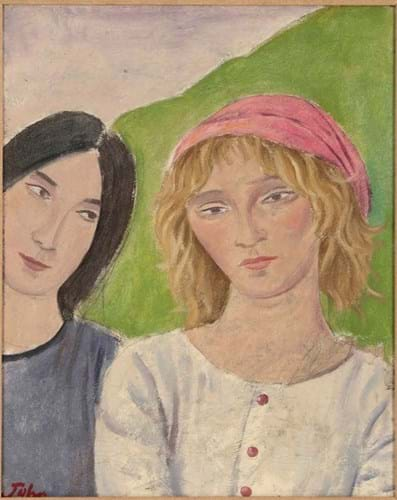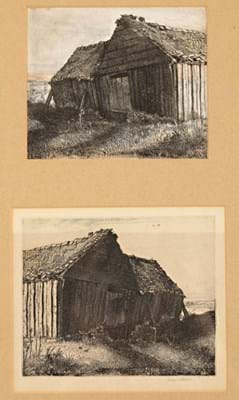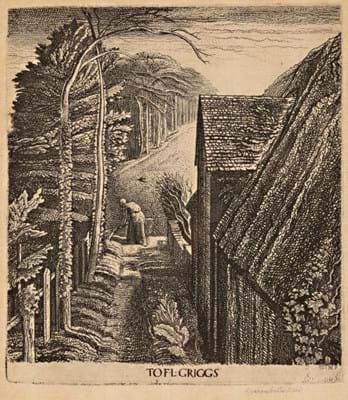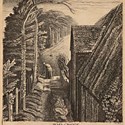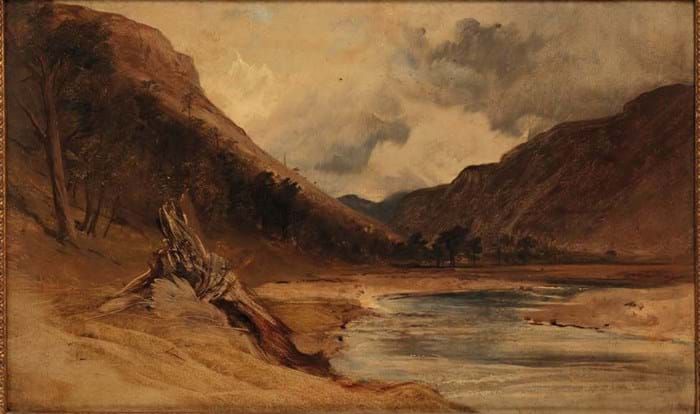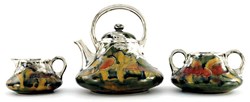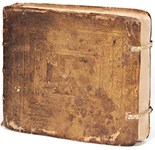The publicity for the show described him as “one of the most distinctive yet elusive British painters of the early 20th century”.
The event duly shed some light on the artist who remains lesser known than many of his contemporaries despite producing a series of evocative and original paintings over his career.
There are a number of reasons, even now, he is regarded as standing somewhat apart from the main developments of British art of his time.
The Brentford-born artist spent much of his early career abroad – he lived in Florence and Paris for several years – and ploughed his own furrow from the start.
Returning to England, he became more recognised as an illustrator, theatre designer and, especially, a mural painter and this may have led to his paintings being somewhat overlooked.
For the most part he remained outside wider artists’ groups and maintained a strong degree of individuality. Indeed, stylistically, his works harked back more to the likes of Sir Edward Burne-Jones as well as much older Italian and early Renaissance artists. He is sometimes classified as a Symbolist and certainly some of his output, especially his allegorical paintings, seem to fit the bill quite well.
While living in Florence, where he studied the art of Giotto and Mantegna, he started painting in tempera and what he gained from practising in this medium remained central to his creative process. One such feature is the way his paintings frequently show people seemingly frozen in a timeless world. They have narrative allusions but are often said to also have an unexplained or unresolved quality.
As an intriguing and, supporters would say, underappreciated draughtsman whose works usually had unsettling subjects, he has attracted something of a cult following. Indeed, some collectors would buy a Cayley Robinson but might not buy other works of this period as they regard him as a highly distinctive artistic voice.
Commercially, though, not too many works have ever been available on the market. Although he exhibited at The Royal Society of British Artists, the Glasgow Institute of the Fine Arts and dealer Leicester Galleries (he also sent a handful of works on paper each year to the annual exhibitions at the Royal Society of Painters in WaterColours), under 80 works have sold at auction over the last four decades (source: Artprice by ArtMarket), the majority being watercolours.
Most recently two works on paper were offered at Christie’s sale of the Peter Rose and Albert Gallichan collection in September, both more than doubling their estimates and selling for £11,000 and £10,000 respectively.
Train journey
This was followed by an eye-catching Cayley Robinson painting which appeared at Duke’s (25% buyer’s premium) of Dorchester on October 8.
The Long Journey was a 16½in x 2ft (42 x 61cm) signed tempera on canvas depicting three figures on a train journey. It had been exhibited at The Royal Academy in 1928.
After the RA show, it was offered at The Leicester Galleries where it was bought for £100 by Kerrison Preston, a collector from Bournemouth who also owned works by artists such as Burne-Jones and Dante Gabriel Rossetti. The catalogue stated that the work had passed ‘thence by descent’.
Duke’s had sold works from the collection of Preston’s daughter Jean previously, most notably the £1.7m Fra Angelico panels in 2007.
The Cayley Robinson picture came with its original receipt from The Leicester Galleries as well as a letter to Kerrison Preston from the artist’s widow thanking him for his appreciation of the work and suggesting the painting may be an analogy between a railway journey and the journey of life. “An old sailor dreaming of the past – the children impatient,” she wrote.
Before this sale, the auction record for Cayley Robinson was for an earlier watercolour from 1902, Study for Twilight that made $55,000 (£35,469) at Sotheby’s New York in 2013. But the fact that this was a major work, an RA exhibit, high quality in terms of execution and quite large in scale for a tempera painting (which are rarer than his oils) gave Duke’s confidence that it would exceed this level.
It was pitched at £40,000-60,000 at the Dorchester saleroom’s ‘Art & Design post 1880’ sale and, after a strenuous competition between a private bidder and an “important international buyer”, it was knocked down to the former at £95,000. Duke’s described the buyer as a “major collector” and the price, which was deemed very high and a bit of a surprise to some members of the trade, was a landmark sum.
Whether this was a one-off sum or will lift the bar for the artist across his entire oeuvre remains to be seen. It may well depend on whether works of comparable quality can be sourced. However, the fact that some striking watercolours by the artist for example are still in circulation may mean there is more to come from Cayley Robinson.
Irish girls
Another tempera on canvas from the same source at the Duke’s sale also topped its predicted levels. Two Irish Girls by Augustus John (1878-1961) had been bought by Kerrison Preston from J Leger and Son in 1939 and again came with some related correspondence between the collector and dealer.
The 15½ x 12½in (40 x 32cm) pencil and tempera on canvas dated from c.1908-10 and was signed to the bottom left.
The artist visited Ireland a number of times over his lifetime and the paintings he made there of the Emerald Isle and its people represent a small but interesting part of his oeuvre. However, his trips were mainly made later in his career after he became friends with William Orpen and other Irish artists, meaning the current work could have been painted in England.
Either way, the artist’s portraits of women (particularly those he was close to) are highly commercial and the £8000-15,000 estimate here was not deemed excessive. After a decent competition, it was knocked down at £25,000 to a well-known buyer of Modern British art.
The price continued the good year Augustus John is having at auction. A record was set in March at Christie’s New York when a chalk portrait of Edie McNeill made $390,000 (£280,185), while a few weeks after the Duke’s sale on October 21 a larger portrait of the actress Vivien Leigh from 1942 which had been commissioned by Laurence Olivier made £55,000 at Christie’s London.
Sutherland works
Also from the same source at the Dorchester sale, a small pen and ink drawing by Graham Sutherland (1903-80) sparked attention against a £5000-10,000 pitch. Warning Camp, a 4¾ x 5¾in (12 x 14.5cm) sketch which was heightened with white, depicted an old barn in West Sussex on the banks of the River Arun.
The drawing was turned into an etching in 1924 with an edition of 62 published by Twenty-One Gallery, London. Today the prints fetch up to around £1300 at auction.
Here, the drawing was framed together with a copy of the etching and this may have helped encourage greater interest with bidders attracted to a ‘two in one’ offering. The lot was eventually knocked down at £24,000 to a private collector.
Even accounting for the extra value added by the print, the price appears to be the second highest for a drawing by Sutherland, only behind a head study of the writer Somerset Maugham that fetched £65,000 at Christie’s in 2015.
Another Sutherland print came from the Kerrison Preston collection. Hanger Hill, a signed etching from 1929, published in an edition of 77, also had a pencil inscription that gave it added interest: To F.L. Griggs A.R.A. With kind regards Graham Sutherland, 27.1.30. Frederick Landseer Griggs was an influential English etcher and illustrator and had taught Sutherland when he studied engraving at Goldsmiths College in London. An attractive proposition against a £500-1000 estimate, it was bid to £4000 – an auction record for this edition.
The Preston lots gave a boost to the sale total and helped raise an overall £293,210 with 184 of 282 lots sold (65%).
The Art & Design post 1880 auction had followed the Dorchester saleroom’s Autumn Fine Art sale the day before which generated £341,390 with 122 of 174 lots selling (70%).
The latter sale included a landscape depicting the Scottish highlands by Sir Edwin Henry Landseer (1802-73). The 10½x 17¼in (27 x 44cm) oil on board did not have any animals depicted (a horse or a stag would have made it more commercial) but it was nevertheless deemed an attractive composition with good colours.
The £5000-10,000 estimate was quickly passed and sold for £20,000 to an English collector.



